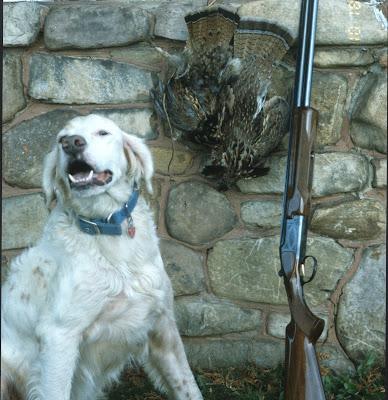 |
| Maggie McGoo: My Last Best Pennsylvania Rough-Shooting Dog |
And so, for the first and only time in my life, we spent the winter gunning pen-raised quail and roosters.
I’m a strong believer too many tame birds ranks high among the many reasons some really well-bred, well-trained dogs never develop into top-notch wild bird mavens. The worst thing is when the young dog learns it can get away with crowding tame birds and breaking that habit is too often way beyond the capabilities of most of us John Q. Amateur dog trainers.
But Mags was different. For whatever reasons, she pointed tame birds staunchly, relocated as necessary but very carefully—catlike—and rarely crowded.
We shot a lot of birds over her points that winter. But every now and then her sire’s infamous stubborn streak reared its ugly head. Acting as if she’d never smelled a bird, busting birds left and right and, worse, refusing to comply voice or whistle commands until she damn-well felt like it.
So starting in early spring and all thru the summer three days on and three days off it was back to the basics in the yard and on the training table. I didn’t like it any more than she did but I vowed to by God break the “stubborn bitch” once and for all or...
Or as Gale said, “Get over it, get on with your life or get done with her, you’re driving yourself mad and me insane.”
If this were a fairy tale we’d all be living happily ever after. Mags would be hunting lights out all day every day. Grouse would be thick and I would be knockin’ ‘em dead. But didn’t exactly work that way. As turned out PA grouse would never again be “thick.” Your intrepid reporter would forever remain the streak shooter of yore. And Mags...
Well when the so-called dog training season opened August 15 (meaning can now run dogs in the field) it seemed she’d hit a wall. Near perfection for days on end always followed by a day or two flipping me the bird.
So I took Gale’s advice. Ditched the yard stuff for good and, for better or worse, took to the woods. Bird numbers were far from great but at least better. Free at last of ropes and chains, Mags turned the corner and morphed into the dog I’d always envisioned.
I always liked the late season best. Less competition we could pretty much hunt wherever, whenever. Grouse seemed to hold a little better and with less food available were far more predictable. And like me, the dogs just seemed a bit more juiced by the snow and cold.
For me, that first week of the late season was by far the best week of grouse hunting ever. With Mags hunting lights out and me shooting out my butt, well after all we’d gone through it was beyond freakin’ wonderful...
But then one day I found Mags pointing at grape tangle. Same look in her eye, same intensity but instead of tail ramrod straight, it was bent and listing to one side. Don’t get me wrong here, frankly I do not give a good goddamn about style points. But when next time she pointed same I knew something was wrong. Worse, in the house more and more we found her standing, tail between her legs, obviously distressed, or worse in real pain.
So I called vet buddy, Mike Moss, and he said, “Bring her in sounds like a ruptured tail-disc.”
To make a long, really sad (actually torturous as hell) story short: X-ray indeed showed a tail-disc injury (not a big deal). But to be safe Mike x-rayed the rest of her spine and though no further spinal injury the one above her chest showed a severely enlarged heart.
For the next 48 hours Mike moved into the office and drained fluid as it developed until at last it coagulated such he could no longer draw with a syringe.
“Chuck, I’ve done all can do. Only thing left is open heart surgery, only place is Cornell, she needs to get there quick, cost is at least $5000, chance of survival less than 5%.”
Next day we buried her on a knoll over-looking the spot she pointed that last grouse.
Up Next: The Montana Wirehairs...





















